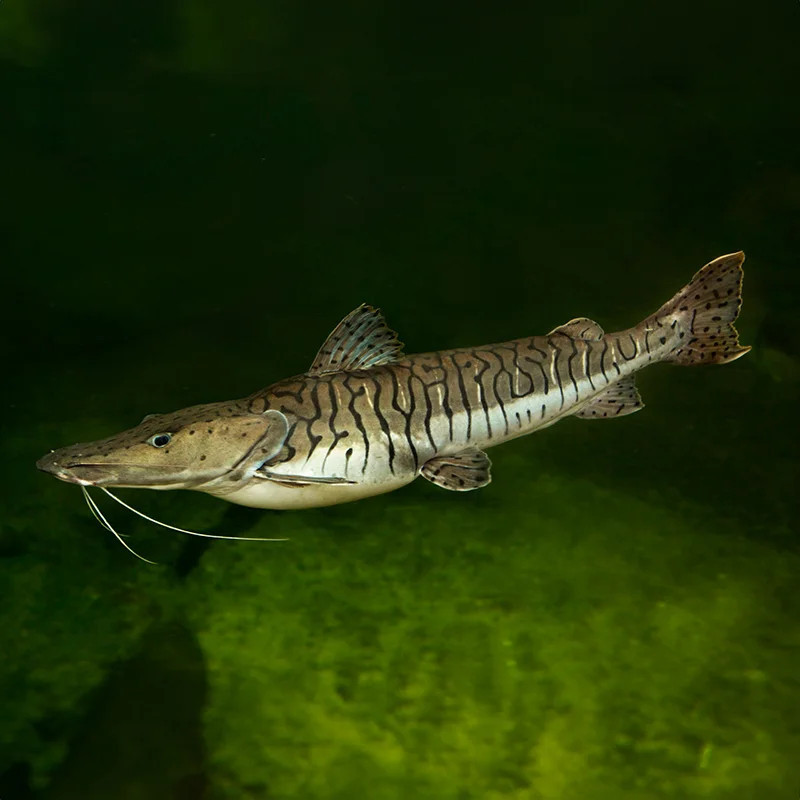Stocks Available
Albino Cory Catfish
SKU:110094
Corydora aeneus
Natural

Stock Available
Introduction: • Common Names: Tiger Shovelnose, Tiger Catfish • Natural Habitat: Native to the Amazon River basin and surrounding waterways in South America, typically inhabiting areas with slow-moving waters, riverbanks, and flooded forests. Physical Characteristics: • Appearance: Recognizable for its elongated, torpedo-shaped body with a distinctive pattern of dark stripes and spots on a lighter background, giving it a tiger-like appearance. The wide, flattened snout resembles a shovel. • Size: Can grow quite large, often reaching lengths of up to 3 feet (90 cm) in captivity, although sizes may vary based on tank conditions. • Lifespan: Average lifespan is around 10-15 years when properly cared for. Habitat Requirements: • Tank Size: Requires a large aquarium, ideally 150 gallons or more, due to its potential size and active nature. • Water Conditions: o Temperature: Prefers a temperature range of 74-82°F (23-28°C). o pH: Should be maintained between 6.0 and 7.5. • Aquascaping: Provide ample hiding spots with caves, driftwood, and plants, as well as open swimming spaces to accommodate its swimming behavior. Diet: • Primary Diet: Carnivorous; in the wild, it feeds on smaller fish, crustaceans, and other aquatic animals. • Supplemental Feeding: In captivity, offer a varied diet that includes high-quality pellets, live or frozen foods such as shrimp, fish fillets, and worms. • Feeding Frequency: Feed once or twice daily, ensuring a balanced diet to promote healthy growth. Compatibility: • Temperament: Generally peaceful but can exhibit territorial behavior as it matures. • Suitable Tank Mates: Best kept with larger, robust fish that can withstand its size, such as larger cichlids and catfish. • Incompatibilities: Avoid small or delicate species that may be seen as prey, as well as overly aggressive fish that could stress the Tiger Shovelnose. Care Level: • Difficulty: Moderate to advanced; requires a larger tank and careful monitoring of water quality to thrive. • Health Monitoring: Regularly observe for signs of disease, including parasites and fin rot, and maintain good water quality. Breeding: • Breeding in Captivity: Rarely bred in captivity, as it typically requires specific conditions that are challenging to replicate. • Spawning: In the wild, spawning occurs during the rainy season, with females laying eggs in secluded areas. Economic Considerations: • Market Demand: Popular among aquarists for its striking appearance and size, leading to a steady demand in the aquarium trade. • Wholesale/Retail Pricing: Prices vary based on size and availability, generally reflecting their desirability. Sustainability and Conservation: • Wild Population: Stable but threatened by habitat destruction and overfishing in some areas. • Aquaculture Efforts: Some success in captive breeding, but wild-caught specimens are still common in the market. • Regulations: Compliance with local and international laws is essential to promote sustainable fishing practices. Conclusion: The Tiger Shovelnose Catfish is a stunning addition to large freshwater aquariums, appreciated for its unique appearance and active behavior. With appropriate care, a spacious environment, and a suitable diet, this impressive species can thrive, providing enjoyment and interest to aquarium enthusiasts for many years.
Data sheet
4 other products in the same category:
Customers who bought this product also bought: